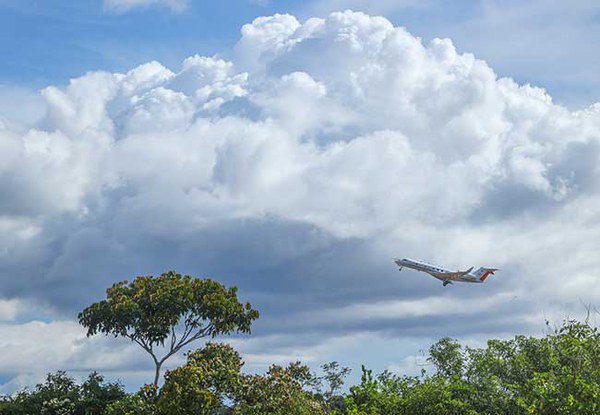9 December 2024
Tropical thunderstorms, plants and chemical processes in the atmosphere have a decisive influence on cloud formation and climate. This is the conclusion of two studies by an international research consortium, one of which was carried out with the participation of Forschungszentrum Jülich and has now been published in the journal Nature.

The Amazon rainforest naturally releases large quantities of the gaseous compound isoprene into the atmosphere. Isoprene is an organic compound produced by many plants during the day and released through their leaves. Until now, it was assumed that this molecule was not widely distributed in the atmosphere because it is rapidly broken down by photochemical processes when exposed to light. A measurement campaign using the research aircraft HALO, in which Forschungszentrum Jülich in Germany was involved, has provided new insights into the isoprene molecule: according to the campaign, nightly thunderstorms transport the isoprene up to 15 kilometres into the atmosphere. There, after sunrise, it reacts photochemically at very low temperatures to form compounds that can form new aerosol particles in large numbers. These particles continue to grow and eventually form condensation nuclei on which water vapour can condense, influencing cloud formation. The mechanism is also likely to have an impact on the global climate, as the particles can be transported over long distances.
These findings once again emphasise the central role of the Amazon rainforest for global climate dynamics. As a "cloud machine", it contributes to cloud formation through natural processes and thus to climate regulation. The results show how important it is to protect ecosystems like the Amazon and to further research their complex interactions with the atmosphere.
As part of the international measurement campaign CAFE-Brazil, which investigated chemical processes in the atmosphere above the Amazon rainforest, an instrument from the Institute of Troposphere at Forschungszentrum Jülich was used on HALO. Special sensors on the upper and lower sides of the aircraft registered sunlight in high spectral and temporal resolution. The velocities at which sunlight splits atmospheric trace substances were calculated from the measured quantities. Knowledge of the speed of these processes is important for a better and more comprehensive understanding of photochemical processes. Among other things, gaseous by-products such as ozone and semi-volatile substances are formed, which create new particles or cause existing particles to grow. These processes influence the chemical composition of the atmosphere, cloud formation and thus also climate dynamics.
This work illustrates how natural processes in the atmosphere can be deciphered using modern technologies and scientific expertise.






